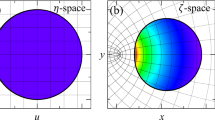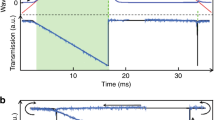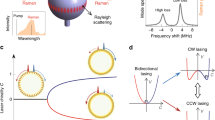Abstract
In dielectric cavities with a rotational symmetry, whispering gallery modes (WGMs) with an extremely long lifetime (that is, a very high Q factor) can be formed by total internal reflection of light around the rim of the cavities. The ultrahigh Q factor of WGMs has enabled a variety of impressive photonic systems, such as ultralow threshold microlasers1,2,3, bio-sensors with unprecedented sensitivity4,5 and cavity optomechanical devices6. However, the isotropic emission of WGMs, which is due to the rotational symmetry, is a serious drawback in applications that require directional light sources. Considerable efforts have thus been devoted to achieving directional emission by intentionally breaking the rotational symmetry7,8,9. However, all of the methods proposed so far have suffered from substantial Q-spoiling. Here, we show how the mode properties of dielectric whispering gallery cavities, such as the Q factor and emission directionality, can be tailored at will using transformation optics. The proposed scheme will open a new horizon of applications beyond the conventional WGMs.
This is a preview of subscription content, access via your institution
Access options
Subscribe to this journal
Receive 12 print issues and online access
$209.00 per year
only $17.42 per issue
Buy this article
- Purchase on Springer Link
- Instant access to full article PDF
Prices may be subject to local taxes which are calculated during checkout





Similar content being viewed by others
References
McCall, S. L., Levi, A. F. J., Slusher, R. E., Pearton, S. J. & Logan, R. A. Whispering-gallery mode microdisk lasers. Appl. Phys. Lett. 60, 289–291 (1992).
Vahala, K. J. Optical microcavities. Nature 424, 839–846 (2003).
Armani, D. K., Kippenberg, T. J., Spillane, S. M. & Vahala, K. J. Ultra-high-Q toroid microcavity on a chip. Nature 421, 925–928 (2003).
Krioukov, E., Klunder, D. J. W., Driessen, A., Greve, J. & Otto, C. Sensor based on an integrated optical microcavity. Opt. Lett. 27, 512–514 (2002).
Vollmer, F. & Arnold, S. Whispering-gallery-mode biosensing: label-free detection down to single molecules. Nat. Methods 5, 591–596 (2008).
Schliesser, A., Rivière, R., Anetsberger, G., Arcizet, O. & Kippenberg, T. J. Resolved-sideband cooling of a micromechanical oscillator. Nat. Phys. 4, 415–419 (2008).
Nöckel, J. U. & Stone, A. D. Ray and wave chaos in asymmetric resonant cavities. Nature 385, 45–47 (1997).
Gmachl, C. et al. High-power directional emission from lasers with chaotic resonators. Science 280, 1556–1564 (1998).
Wiersig, J. & Hentschel, M. Combining directional light output and ultralow loss in deformed microdisks. Phys. Rev. Lett. 100, 033901 (2008).
Pendry, J. B., Schurig, D. & Smith, D. R. Controlling electromagnetic fields. Science 312, 1780–1782 (2006).
Leonhardt, U. Optical conformal mapping. Science 312, 1777–1780 (2006).
Schurig, D. et al. Metamaterial electromagnetic cloak at microwave frequencies. Science 314, 977–980 (2006).
Cai, W., Chettiar, U. K., Kildishev, A. V. & Shalaev, V. M. Optical cloaking with metamaterials. Nat. Photon. 1, 224–227 (2007).
Philbin, T. G. et al. Fiber-optical analog of the event horizon. Science 319, 1367–1370 (2008).
Narimanov, E. E. & Kildishev, A. V. Optical black hole: broadband omnidirectional light absorber. Appl. Phys. Lett. 95, 041106 (2009).
Aubry, A. et al. Plasmonic light-harvesting devices over the whole visible spectrum. Nano Lett. 10, 2574–2579 (2010).
Wang, Q. J. et al. Whispering-gallery mode resonators for highly unidirectional laser action. Proc. Natl Acad. Sci. USA 107, 22407–22412 (2010).
Wiersig, J. & Hentschel, M. Unidirectional light emission from high-Q modes in optical microcavities. Phys. Rev. A 73, 031802(R) (2006).
Valentine, J., Li, J., Zentgraf, T., Bartal, G. & Zhang, X. An optical cloak made of dielectrics. Nat. Mater. 8, 568–571 (2009).
Gabrielli, L. H., Cardenas, J., Poitras, C. B. & Lipson, M. Silicon nanostructure cloak operating at optical frequencies. Nat. Photon. 3, 461–463 (2009).
Li, J. & Pendry, J. B. Hiding under the carpet: a new strategy for cloaking. Phys. Rev. Lett. 101, 203901 (2008).
Xu, L. & Chen, H. Conformal transformation optics. Nat. Photon. 9, 15–23 (2015).
Robnik, M. Classical dynamics of a family of billiards with analytic boundaries. J. Phys. A 16, 3971–3986 (1983).
Heller, E. J. Bound-state eigenfunctions of classically chaotic hamiltonian systems: scars of periodic orbits. Phys. Rev. Lett. 53, 1515–1518 (1984).
Hentschel, M., Schomerus, H. & Schubert, R. Husimi functions at dielectric interfaces: inside-outside duality for optical systems and beyond. Europhys. Lett. 62, 636–642 (2003).
Schwefel, H. G. L. et al. Dramatic shape sensitivity of directional emission patterns from similarly deformed cylindrical polymer lasers. J. Opt. Soc. Am. B 21, 923–934 (2004).
Lee, S.-Y., Ryu, J.-W., Kwon, T.-Y., Rim, S. & Kim, C.-M. Scarred resonances and steady probability distribution in a chaotic microcavity. Phys. Rev. A 72, 061801(R) (2005).
Tomes, M., Vahala, K. J. & Carmon, T. Direct imaging of tunneling from a potential well. Opt. Express 17, 19160–19165 (2009).
Lee, S.-Y. & An, K. Directional emission through dynamical tunneling in a deformed microcavity. Phys. Rev. A 83, 023827 (2011).
Bittner, S., Bogomolny, E., Dietz, B., Miski-Oglu, M. & Richter, A. Dielectric square resonator investigated with microwave experiments. Phys. Rev. E 90, 052909 (2014).
Wiersig, J. Boundary element method for resonances in dielectric microcavities. J. Opt. A 5, 53–60 (2003).
Acknowledgements
This research at KNU (S.-Y.L, J.-W.R., I.K, J.-H.H and M.C) was supported by Basic Science Research Program through the National Research Foundation of Korea (NRF) funded by the Ministry of Education (No. 2013R1A1A2065357). J.-W.R was supported by Project Code (IBS-R024-D1). H.-S.T was supported by the NRF funded by the Ministry of Education (2013R1A1A4A03008577). KAIST (Y.K and B.M) was supported by Nano·Material Technology Development Program (2015036205), the World Class Institute Program (No. WCI 2011-001) and the Pioneer Research Center Program (2014M3C1A3052537) through the NRF as funded by the Ministry of Science, ICT and Future Planning (No. 2012R1A2A1A03670391 and No. 2015001948). This work was supported by the Center for Advanced Meta-Materials funded by the Ministry of Science, ICT and Future Planning as Global Frontier Project (CAMM-2014M3A6B3063709).
Author information
Authors and Affiliations
Contributions
Y.K., S.-Y.L., J.-W.R., I.K., M.C. and B.M. conceived the original idea. S.-Y.L., I.K. and M.C. performed theoretical calculations. Y.K., S.-Y.L. and J.-W.R. performed numerical simulations. Y.K. prepared the experimental set-up and performed the experiments. Y.K., S.-Y.L., J.-W.R., I.K., M.C. and B.M. analysed the data. Y.K., S.-Y.L., J.-W.R., I.K., J.-H.H., H.-S.T., M.C. and B.M. discussed the results. Y.K., S.-Y.L., J.-W.R., I.K., M.C. and B.M. wrote the manuscript, and all authors provided feedback.
Corresponding authors
Ethics declarations
Competing interests
The authors declare no competing financial interests.
Supplementary information
Supplementary information
Supplementary information (PDF 433 kb)
Rights and permissions
About this article
Cite this article
Kim, Y., Lee, SY., Ryu, JW. et al. Designing whispering gallery modes via transformation optics. Nature Photon 10, 647–652 (2016). https://doi.org/10.1038/nphoton.2016.184
Received:
Accepted:
Published:
Issue Date:
DOI: https://doi.org/10.1038/nphoton.2016.184
This article is cited by
-
Exploring localized ENZ resonances and their role in superscattering, wideband invisibility, and tunable scattering
Scientific Reports (2024)
-
Conformal optical black hole for cavity
eLight (2022)
-
The required acoustic parameters simplification of invisibility cloaks and concentrators using the impedance-tunable coordinate transformation
Scientific Reports (2021)
-
Engineered disorder in photonics
Nature Reviews Materials (2020)
-
Optimization of conformal whispering gallery modes in limaçon-shaped transformation cavities
Scientific Reports (2019)



